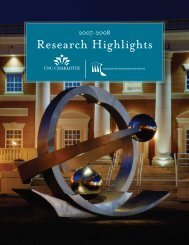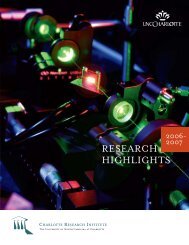rESEArCH HIGHLIGHTS - Charlotte Research Institute - University ...
rESEArCH HIGHLIGHTS - Charlotte Research Institute - University ...
rESEArCH HIGHLIGHTS - Charlotte Research Institute - University ...
Create successful ePaper yourself
Turn your PDF publications into a flip-book with our unique Google optimized e-Paper software.
oyster populations. In her recent publication in the Journal of Experimental Biology (Winter 2007), Dr. Sokolovadiscusses how warmer water temperatures (resulting from global warming) have been found to magnify theeffects of toxins such as cadmium on oysters. Early outcomes of this research include nine papers with datathat could be used to predict the effects of global warming on marine life as well as affect tougher standardsfor water pollution levels. In a collaborative project with Dr. Monty Hughes (Cell Biology), Dr. Sokolovais funded by a North Carolina Sea Grant to learn how Dermo (a deadly oyster disease caused by a parasite)gets into East coast oysters and overcomes their immune systems. Specifically, the biologists are studying themechanism of apoptosis (cell death) and the effects of environmental stressors (such as temperature andheavy metals) on oyster immunity. The overall goal of the study is the development of preventive measures.BioTrackers: Bacteria DetectiveIn a different perspective of environmental biology, geneticist Dr. Todd Steck and his start-up company,BioTrackers, are focused on finding more effective ways to keep public water sources free of bacteria andother harmful agents by developing a genetically modified organism (GMO) that will shadow the bacteria.The GMO will behave exactly like the bacteria, allowing Dr. Steck to observe how the bacteria survive andmove. Success in this project will provide information needed to create biocidal agents to kill bacteria aswell as a more effective way to track the bacteria to its source in our water supplies (i.e., leaks in sewer linesinfecting our water sources).Biomedical <strong>Research</strong>: UnderstandingLiver FibrosisHow do we prevent liver fibrosis (scar tissueforms—recovery is possible) from progressingto cirrhosis (scar tissue replaces healthy tissueand prevents liver from functioning normally—non-recoverable damage)? Drs. Jian Zhang andLaura Schrum are exploring the answer to thisquestion from different angles. Dr. Zhang hasNational <strong>Institute</strong>s of Health (NIH) funding toexamine the role of the enzyme ThromboxinA2, a vasoconstrictor (blood vessel constrictor),in early stage portal hypertension (potentiallyfatal high blood pressure). The goal is to finda way to reverse the process so that the liver isstill recoverable. Dr. Laura Schrum has NIHfunding to look at hepatic stellate cells (cell typesinvolved in liver fibrosis) to determine how toinhibit the activation of collagen productionthat occurs with liver fibrosis. When the liveris injured due to hepatotoxic factors such asalcohol, hepatic stellate cells synthesize collagenas a repair mechanism; however, excessive anduncontrolled accumulation of collagen can leadto liver dysfunction and ultimately liver cirrhosis,which can be fatal. Discovering how this functionworks could lead to the prevention of cirrhosisand save the lives of liver patients.Dr. Laura Schrum (Biology) and PhD student Cathy Moore lookingat protein expression in hepatic stellate cells (HSC) using immunocytochemistryto understand contractile properties of HSC fortreatment of portal hypertension in liver fibrosis.21<strong>Research</strong> Highlights 2006-2007





